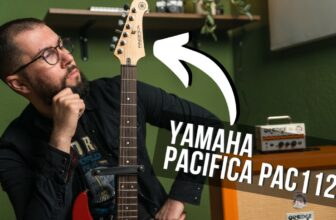Types Of Electric Guitars (Body, Materials, Pick-Ups)
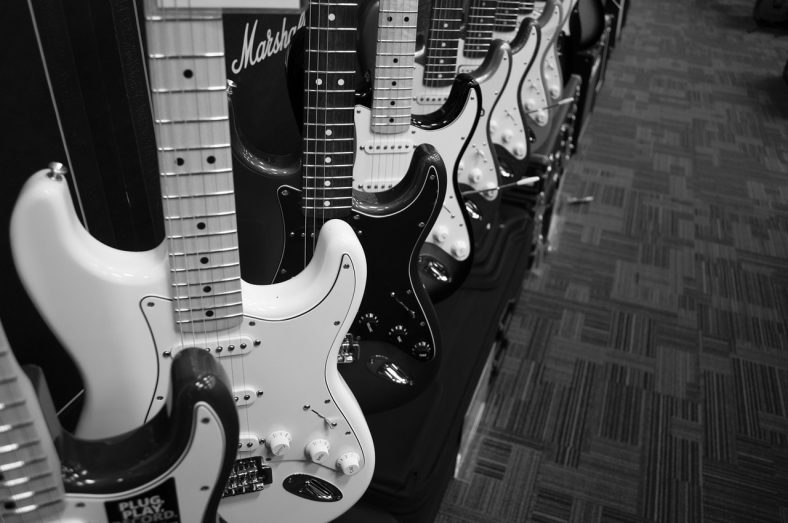
The electric guitar has been in development for almost nine decades and it’s no surprise that it has changed in a variety of ways. There are several types of guitars available nowadays, each with its own set of characteristics.
The electric guitar has been in development for almost nine decades and it’s no surprise that it has changed in a variety of ways. There are several types of guitars available nowadays, each with its own set of characteristics.
Electric guitars can be classified in the following ways: body style, wood type, neck construction, and pickup types. To successfully understand this and learn something new, keep reading and find out about the different types of electric guitars.
Without further ado, let’s dive in!
Types of Body Styles
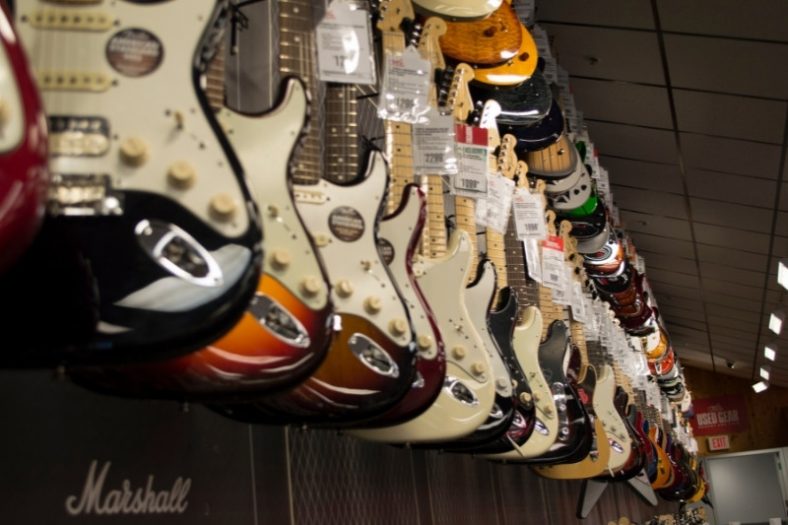
There are three main types of electric guitars in terms of body styles, including solid body, hollow body, and semi-hollow body guitars. As the names suggest, solid-body guitars feature a body made from a solid piece of wood, hollow-body guitars have a hollow body like acoustic guitars, and semi-hollow guitars are partially hollow with a center block inside them.
Solid-body Guitars
A solid body guitar is an instrument made from a solid piece of wood without any resonating air spaces inside it. The most famous examples are Fender Stratocaster and Gibson Les Paul guitars. Compared to other body types, these guitars have significantly more sustain and can handle distortion well with great resistance to feedback.
The first solid-body guitar was made by the guitarist, luthier, and inventor Les Paul in 1941. He attached a neck to a rectangular-shaped block of wood to create his famous “log” guitar, the first solid-body guitar in history.
The advantages of these guitars are the increased sustain along with more resistance to feedback, making these guitars perfect choices for tones with high overdrive and distortion. That is the reason behind their popularity in rock and metal genres.
As time passed, many versions of solid body guitars were invented with slightly different characteristics. Let’s check all of them to see what they offer differently from each other.
Stratocaster
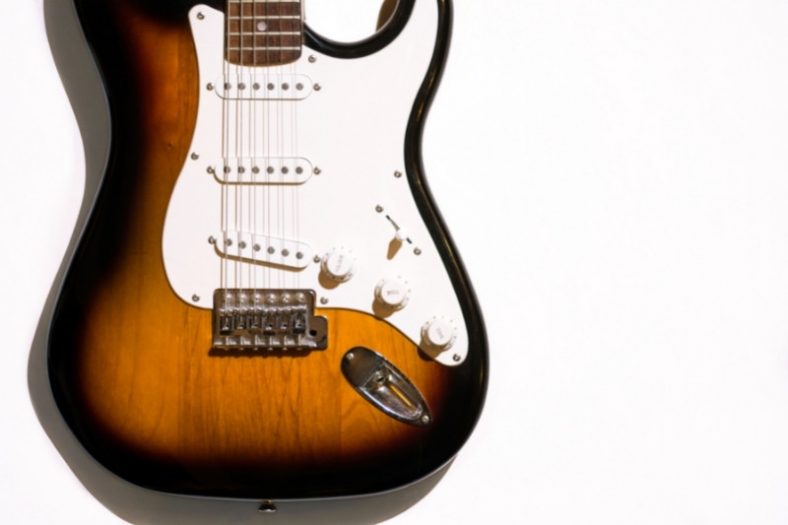
The most recognizable solid-body guitars are undoubtedly Stratocasters. It is one of the first mass-produced solid-body electric guitar models and is widely used today and throughout history due to its versatility. These iconic guitars can be used for many genres like blues, rock, heavy metal, country, folk, soul, R&B, pop, and jazz.
The Stratocaster body shapes are commonly called S-style or Strat-style guitars. The typical design features a double-cutaway body often made of ash or alder, tremolo bridge, bolt-on neck, and a vintage look. It’s not hard to understand why the Stratocaster is the most popular and recognizable solid-body guitar.
Regarding the sound, it is hard to describe a Strat’s tone as it is used in many different styles and musical genres, mainly these guitars have great mid-range focused, bright and crisp tones. The primary purpose of Stratocaster was to play blues, but it evolved to a broader region after that.
Countless iconic and famous guitarists use Stratocasters like Jimi Hendrix, David Gilmour, Eric Clapton, Jeff Beck, George Harrison, Yngwie Malmsteen, Mark Knopfler, and many more.
Les Paul
Les Paul is one of the first mass-produced solid-body guitars in history, along with Fender Stratocasters and Telecasters. It is one of the best-known electric guitar types today, and thanks to its versatility, Les Paul guitars are used in many genres from rock, pop, reggae, punk to blues, jazz, and heavy metal.
The guitar has a balanced response with great high-frequencies and an impressive sustain. Arguably, the best sustain is provided with Les Paul-style guitars among different body style types.
Although it thrives with distorted tones, the clean tones of Les Pauls are also fantastic, making the guitar more versatile and suitable for different genres like jazz, pop, reggae, blues, and R&B.
The typical design features a classic single-cutaway body made of Mahogany, a carved maple top, and a set-in neck with a rosewood fingerboard.
There are some different designed bodies in the range of Les Pauls, including solid, solid-arched, and solid-chambered models. Solid-arched models have an arched top with a maple cap, while the solid-chambered models feature a chambered body with some small cavities under the top.
Many iconic guitarists used Les Paul-style guitars in history, including Jimmy Page, Eric Clapton, Bob Marley, Slash, Joe Perry, Al Di Meola, Billy Gibbons, and many more.
Telecaster
Fender Telecaster is the first mass-produced electric guitar, which was initially named Broadcaster. Like Stratocasters, it is a versatile guitar used for many genres like country, rock, blues, jazz, rock, soul, folk, R&B, and alternative rock.
The Telecasters, or Teles, or T-style guitars mainly feature a flat asymmetric single-cutaway solid body, a bolt-on neck, a metal plate to which the bridge pickup is placed, and a fixed bridge.
The guitar was mainly used in the country genre due to its bright, rich cutting tone. However, the guitar can also produce mellow, warm, bluesy jazz tones, making them ideal for a wide range of genres. However, it is hard to get heavy rock tones from Telecasters.
Many guitarists from different genres used Teles at some point in their careers, such as Muddy Waters, Keith Richards, Tom Morello, Jimmy Page, Andy Summers, and many more.
Superstrat
Superstrat style guitars are actually modified Stratocasters to use for heavier genres of rock like metal and hard rock. They feature higher-output pickups, often slimmer necks for shredding, and Floyd Rose tremolo bridges for more tremolo bar action.
Manufacturers like Jackson, Ibanez, Charvel, and Sechter are known for their high-quality Superstrat guitars.
Superstrat guitars have the body shape of a Stratocaster but are designed for more modern and heavier tones with different woods, neck shapes, bridge systems, and pickup configurations. They often have at least one humbucker pickup instead of classic single coils of Stratocasters to provide heavier tones.
The superstrats deliver more innovation, control, and playability options. That is why most shredders and metal, hard rock players use them in studios and stages.
The most famous Superstrat players are Steve Vai, Joe Satriani, Dave Murray, Eddie Van Halen, and John Petrucci.
SG & Flying V
Gibson SG and Gibson Flying V are similar solid body electric guitars with different body shapes. They are typically equipped with double humbuckers and are suitable for rock and metal genres.
The Flying V has the V shape, which looks pretty attractive and offers more comfort when reaching higher frets. The SG is Gibson’s best-selling model of all times and features a typically mahogany body, double-cutaway design, and contoured body.
Both guitars are good choices for rock and metal, with versatile tones depending on the pickups used. These guitars are widely used for rock, hard rock, metal, and blues.
Angus Young, Tony Iommi, Bernard Sumner are among the famous guitarists who use SG guitars, while Albert King, Dave Mustaine, and James Hetfield are known for their Flying V-shaped guitars.
Offset
Offset-shaped guitars have many variations, such as the Jaguar, the Jazzmaster, the Firebird, and the Mustang. Although these guitars have subtle nuances between them, they are all known for their bright, clear sound with subtle bass and mid responses.
The offset guitars can be distinguished with their striking asymmetrical body design. They seem like leaning to one side with their unbalanced designs.
Offset guitars often provide a high playing comfort and are known for their tones that can go well with tones that have lots of effects. That is why they are commonly used in alternative genres, shoe-gaze, and grunge. They are quite versatile guitars that can be used for rhythm and lead sections.
Offset guitars often feature complex circuitry making them more versatile in terms of sonic performance and making switching between tones quicker and easier. With their versatile tone, full and rich sound, and comfortable playability, they are also excellent choices for instrumental genres.
The great vintage looks, sonic versatility, rich and full tones as well as smooth playability of modern offset guitars make them quite attractive for many players. Kurt Cobain, Elvis Costello, John Frusciante, Tom Verlaine, and Rory Gallagher are just some of them.
Semi-hollow and Hollow-body Guitars
Hollow body guitars are the first-ever electric guitars. They were created similar to acoustic guitars with entirely hollow bodies. Semi-hollow guitars are also hollow inside, but they feature woodblock in the center. The two body types look and perform very similarly.
The hollow body and semi-hollow body guitars are highly acoustic guitars that provide a loud and present sound when strummed unplugged. These types of guitars shine with their warm, clean, and acoustic-like natural tones.
While semi-hollow body guitars have a tone between the hollow body and solid body guitars, they have less sustain and less low-end focus compared to solid body guitars. They are also more susceptible to feedback, especially with high gain, as they have large cavities inside them. But, semi-hollow body guitars’ center blocks do a relatively good job softening the feedback.
These guitar types are great for playing jazz, and many jazz players prefer them. That is why hollow-body guitars are also known as “jazz box” guitars. They provide round, natural, acoustic-like warm, clean tones.
However, semi-hollow body guitars are also used for classic rock, blues, and similar styles, which require low-gain tones, thanks to their higher feedback resistance. They are preferred by guitarists who want the lightness and performance of a solid body guitar but with the touch of rounder, more natural, and acoustic sound of a hollow body guitar.
Gibson ES-335
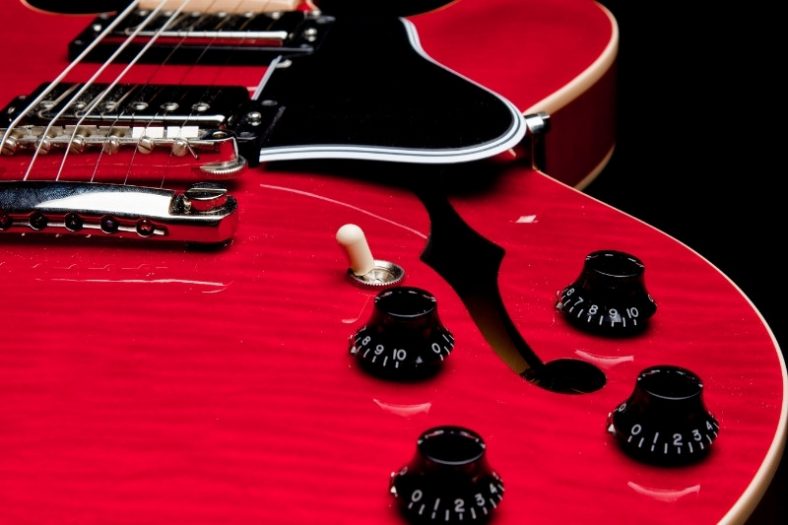
The most famous semi-hollow body guitar is Gibson ES-335 which is the first commercial semi-hollow body guitar, created in 1958. It is also known as a semi-acoustic guitar, and there are tons of variations of it which were produced later based on the ES-335 design.
The guitar is characterized by the solid maple wood block located in the center of its body. The block divides the body into two hollow chambers and tames the feedback, making the guitar great for jazz, blues, classic rock, and rock ‘n roll.
Thanks to the warm and dark tone of a hollow body and the feedback resistance of a solid body, many iconic guitarists used Gibson ES-335 or some of its variations. Chuck Berry, BB King, Dave Grohl are some of the most famous users.
Gibson ES-175
The first fully-electric hollow body guitar was the Gibson ES-175, created in 1949. It is one of the most famous and iconic jazz guitars of history, used by many legendary guitarists. It was named “workhorse of modern Jazz guitar,” thanks to its warm, clean, articulate, and rich tone.
The guitar features an archtop, one or two pickups, a trapeze tailpiece, and a Tune-O-Matic bridge, along with an all-laminate maple construction, which tames the feedback better than most hollow body guitars. That is the reason behind the guitar’s sonic versatility, as it can stand up to higher gain and volume levels.
The guitar became a base design for hollow body guitar makers. Many makers tried to replicate or make variations but could never reach the same sound quality and versatility.
ES-175 is considered one of the most iconic jazz guitars and was used by legendary guitarists like Joe Pass, Jim Hall, Pat Metheny, and Steve Howe.
Epiphone Casino
One of the most iconic hollow-body guitars of music history is undoubtedly Epiphone Casino. It is an archtop guitar with a Thinline fully hollow body, which was the most sold Epiphone guitar during the rock n’ roll era.
Countless legendary guitarists preferred Casino as their main instrument, thanks to its thick and rich, slightly gnarly and biting pure rock n’ roll sound.
Epiphone Casino is equipped with a trapeze-type tailpiece, dual P-90 pickups, laminated maple top, back, and sides. The guitar combines the deep and warm tones of a jazz-box guitar with the bite of a semi-acoustic electric, offering plenty of sonic complexity and versatility.
It is a great guitar for jazz, blues, rock n’ roll, and rockabilly tones, but of course, it is prone to feedback with high gains and volumes, as with any hollow body guitar. Tons of iconic guitarists used Epiphone Casino, such as Keith Richards, John Lennon, George Harrison, Paul McCartney, Noel Gallagher, and Gary Clark Jr.
Gretsch 6120
Although Gibson was the pioneer manufacturer of hollow-body guitars with many innovations, some other producers like Gretsch offered various models that got pretty famous, like Gretch 6120. Gretsch followed the new approach of Gibson and created a model that many great rockabilly artists used.
Released in 1955, the guitar had a 3” deep, 16” complete hollow body with laminated maple, Tune-O-Matic bridge with rosewood base or Bigsby cast aluminum bridge, and a relatively narrow and skinny maple neck.
The sound was more suitable toward rock n’ roll tones compared to other hollow body guitars of the era. Besides its stronger and fatter bass frequencies, it also has a hotter output and more sustain.
Countless guitarists played the Gretsch 6120 model in the studio and stage, including George Harrison, Brian Jones, Pete Townshend, Chet Atkins, Eric Clapton, and Duane Eddy.
Different Types of Wood
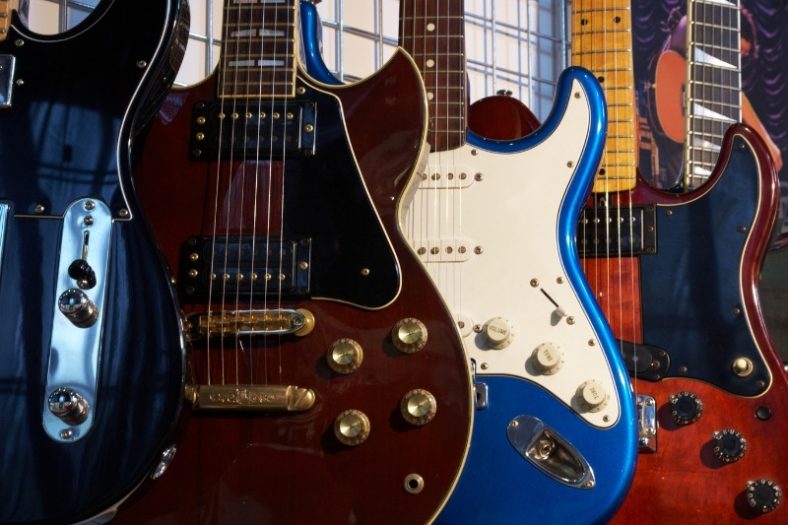
The wood type has a critical impact on the tone of the guitar. Various types are used for the body, neck, and fingerboard. We will stick to the body wood for now, and the wood types that are most frequently used are Alder, Ash, Mahogany, Basswood, Maple, Corina, etc.
Alder
Alder is probably the most popular wood that is used for the guitar body. The main reason lies in the fact that alder delivers a well-balanced tone. Mid-range tones are amazing, while lows sound good as well.
On the other side, highs aren’t that spectacular but sound decent in most cases. Sustain is also pretty good.
Alder isn’t a particularly hard type of wood, so it’s easy to work with it. However, things like texture and color are not its strong point, so paint and finish are required. Most Strat and Tele guitars are made of alder.
Ash
Ash is another popular wood among Fender guitars and their clones. Players like this wood because it’s very light, but resonates amazingly. In terms of tonal characteristics, this wood isn’t that good in lows, but highs sound much better compared to alder.
Mid-range tones sound spectacular. Also, this wood looks amazing, so most ash guitars feature a translucent finish.
Mahogany
When it comes to electric guitars, there are two worlds – Fender and Gibson. Other guitars are somewhere between and wood type is the main reason.
While Fender guitars are usually made of ash or alder, Gibson guitars are famous for mahogany. As you may presume, these are completely different wood types.
Muddy lows and blurred highs are the main characteristics of this wood, while the tone is extremely warm, which makes it perfect for jazz guitars. On the other side, endless sustain makes this wood perfect for high-gain genres.
Basswood
This is an affordable wood, so it’s no wonder that it is the most common among budget guitars. However, it is also used for high-quality products, particularly for superstrats. This is a quite soft wood, easy to work with.
Visually, it doesn’t look particularly good, so a non-translucent finish is required. Soundwise, basswood is very balanced. Some would say that the tone is quite flat, but that can be significantly improved with the right pickups.
Maple
Maple is a pretty hard and heavy wood, so it’s no wonder that most guitar necks are made from it. This wood is used for the body as well, particularly for the top of it. In terms of tonal characteristics, it is very bright, with accentuated mids and highs. On the other side, lows are pretty tight.
Neck Construction
Another very important aspect of electric guitars is neck construction. There are three main types: set neck, bolt-on, and neck-through electric guitars.
The set neck is the oldest method, common for pretty much all string instruments. The neck is fitted into the body and glued. Such a design ensures an excellent connection between neck and body, so you may count on excellent resonance.
In practice, this means an extremely rich tone and tons of sustain. Typical examples are Les Paul and hollow-body guitars. On the other side, bolt-on necks are typical for Strat and Tele types of guitars. In this case, the neck features some kind of a rectangular heel, while the body features the same-shaped body pocket.
The neck is fixed with a couple of screws and a metal plate. With such a design, you can’t count on any spectacular sustain. On the other side, the attack and dynamics are amazing, while the tone is very bright.
Finally, there is a neck-through guitar design. The neck extends to the body, making a central block of the body. The two parts are the same piece of wood, while the sides are glued or laminated.
As you may presume, sustain is superior, while higher frets are also easier to reach. On the other side, these guitars are more complicated for production, so the price is higher compared to the first two types.
Pickup Types
Pickups also play a very important role when it comes to the electric guitar tone. The first type that comes to mind is a single-coil pickup. These pickups are typical for Fender guitars and they are characterized by excellent clarity and bright tone.
On the other side, humbuckers are typical for Gibson guitars, both hollow and solid body guitars. The tone is notably richer and has a higher output. Also, no hum is typical for single coils. These pickups are perfect for jazz, but also hi-gain tones.
Finally, there are P90 pickups. These are practically single-coil pickups but with much wider coilings, so the tone is richer compared to single coils, but also more articulated compared to humbuckers. P90 pickups were popular in the ‘50s and ‘60s, but many players use them today as well.
Conclusion
So, electric guitars are categorized according to their different characteristics, such as the body style, types of wood that are used, neck construction, and pickup types. All the instruments in different categories serve different purposes, genres, and playing styles to create the best possible tone and playing experience.
As technology advanced, many different designs and models were invented that do not really fit in these categories or fit more than one category. However, besides those exceptions, you can use these classes to choose the ideal instrument for you.

